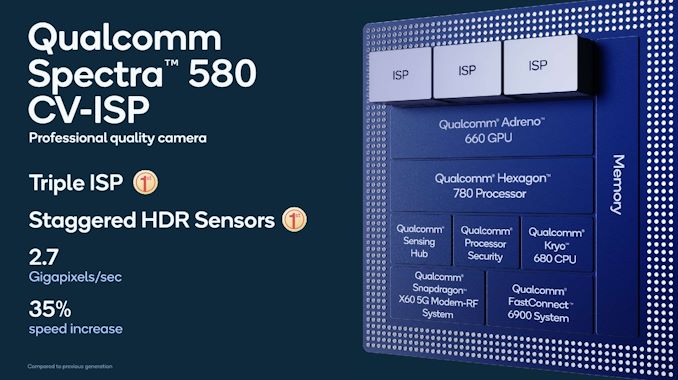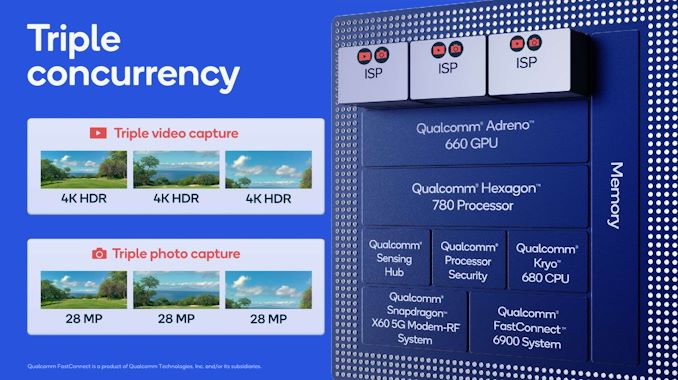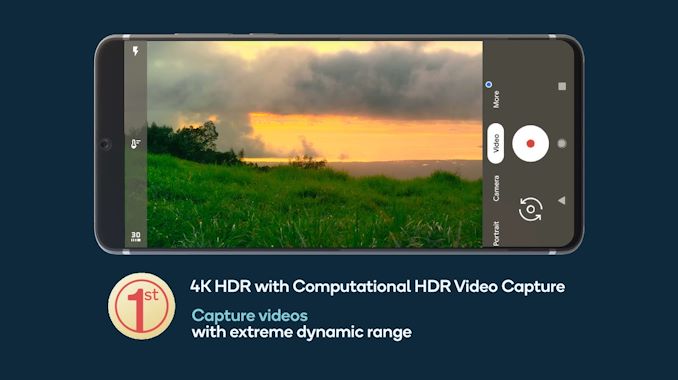Qualcomm Details The Snapdragon 888: 3rd Gen 5G & Cortex-X1 on 5nm
by Andrei Frumusanu on December 2, 2020 10:00 AM EST- Posted in
- Mobile
- Qualcomm
- Smartphones
- SoCs
- 5G
- Cortex A78
- Cortex X1
- Snapdragon 888
Triple ISPs: Concurrent Triple-Camera Usage
Interestingly enough, during yesterday’s keynote event, Qualcomm described themselves as a camera company, which is a funny way to see things, but actually somewhat makes sense given the large leaps in smartphone camera capture capabilities over the recent years.
The new Snapdragon 888 pushes the envelope in terms camera abilities by adding a whole new independent third ISP to the SoC, allowing the SoC to now run three independent camera modules concurrently, opening up new use cases for vendors and camera applications.
The new triple-ISP architecture now increases the overall pixel processing throughput by 35% to 2.7Gigapixels/s, allowing for concurrent usage of up to three 28MP sensors with zero shutter lag captures. Alternatively, you can use a combination of 64+25MP sensors with ZSL, or a single 84MP sensor with ZSL. There’s still also support for ultra-high-resolution sensors up to 200MP, but image captures here don’t support ZSL.
Allowing concurrent captures of three sensors now allows for the holy trifecta of ultra-wide-angle, wide-angle and telephoto modules to capture a scene at the same time, allowing for more interesting use-cases such as image stitching and image fusion to happen to seamlessly.
One interesting capability that Qualcomm was advertising is triple-stream 4K HDR video recording. That’s a bit of an odd-ball use-case as I do wonder about the practical benefits, but I do at least hope that the new triple ISP system allows for more seamless switching and zooming in and out between the various camera modules during video recording.
Video recording capabilities this year don’t seem to have changed, compared to the Snapdragon 865. This means 4K120 or 8K30 are still the peak capture modes, supporting also slow-motion of 720p960. Formats are also unchanged, with HEVC encoding in HDR formats such as HDR10+ or Dolby Vision being supported.
AV1 decoding didn’t make the cut this year unfortunately, which means wide-spread adoption in mobile for the codec will be delayed for another year.
While the video encoding formats haven’t changed, the image processing capabilities for HDR capture has. Thanks to the new ISPs and the raw performance throughput, the new Snapdragon 888 will be able to capture 4K HDR footage with the more advanced computational HDR processing being applied on each and every frame of the video.
Qualcomm claims that the new ISP in the Snapdragon 888 is the first to support new next-generation staggered HDR sensors.

Source: OmniVision
These are sensors that can have multiple rolling shutters, meaning sensor line readouts, active at the same time on the sensor. Instead of taking multiple exposures one at a time sequentially by scanning out the sensor matrix from start to finish, the sensor will start another exposure immediately after the completed line read-out, reducing the time in-between exposures greatly. This should allow for significant less motion ghosting between the exposures and a sharper resulting recombined HDR image capture than current generation sensors which only have a single active line readout on the sensor.
While we haven’t actually heard of such sensors from Samsung or Sony yet, Qualcomm is adamant that we’ll be seeing smartphones in 2021 employing this new technology.
A further improvement for still-picture captures is the advancement of the new multi-frame noise reduction engines inside of the ISPs. It’s said that the quality of the noise reduction has been improved this generation, allowing for even better low-light captures with the native capture mode (no computational photography).















123 Comments
View All Comments
lmcd - Wednesday, December 2, 2020 - link
820 was absolutely a disaster. Its errata list was too great for Windows kernel support, likely at the ISA implementation, and likely deeply-rooted enough to justify dropping the entire endeavor.Silver5urfer - Wednesday, December 2, 2020 - link
How is Windows Kernel coming into the picture ?It was about the Android performance and 64Bit compat due to Apple's move first and 810's ultimate disaster which even killed HTC entirely. 820 processor was very fast and still holds up, just like 805 but the latter was 32bit, One can see comparison of that with Apple's A9.
Entire endeavor was dropped because there's no need. Why do you think Qcomm develops a lot of the Radio and etc and tons of R&D ? Patents. That's what Qcomm is all about and they tried that with Centriq. But ARM on DC market is a dead end, so many years of articles here on AT and STH, so far no one is there on that side the only option which was showing some metric of performance that too for small loads is Graviton2. Only when there's a need then these companies push, which is money. Apple does it because they want to hold that position to leverage their pricing justification of the iPhone. Looking at any Android top flagship vs iPhone real world application performance tests and gaming loads it shows why there is no need for Qcomm to push, they push where there is money, GPU and NPU, ISP, Radio RF.
techconc - Thursday, December 3, 2020 - link
Qualcomm and Samsung had different problems with their CPU designs. Qualcomm had a pretty competitive design. Their problem was getting blind-sided by the A7 with 64bit. They didn't have a 64bit design in their pipeline and had to abandon their own work and go back to ARM reference designs just to have something remotely competitive.Samsung found out the hard way that chip design isn't easy. Making a more powerful chip is one thing, but being energy efficient (and powerful) is quite another thing. They eventually scuttled their custom chip hopes as well.
That leaves ARM. ARM will design what their customers want. It's not clear that customers are complaining to ARM that they want more powerful cores. Maybe the X1 is a step in that direction. However, we can see lots of cost cutting examples in the SD888, so it's not clear that there is an appetite for an Apple like design for Android based SoC vendors.
ZolaIII - Thursday, December 3, 2020 - link
A55 is not inferior, it's still the best in order A core ARM ever made. The so called Apple little core's are simple OoO core's inferior but closest to compare to A73. Problem is ARM never made a newer incarnation of A73 suitable for DynamIQ clusters. They did make Neoverse E1 and A65 which both thanks to SMT aren't exactly suitable for mobile phones and we didn't see any of their actual silicone implementations.I don't see a L3 victim cache as the way to go as it's limiting in many aspects. Faster RAM & bigger L2 cache should be a way to go.
Apple just makes your wallet cry.
AntonErtl - Thursday, December 3, 2020 - link
The A75 is derived from the A73 (3-wide instead of 2-wide), and AFAIK supports DynamIQ. And looking at Andrei's M4 review, the A75 appears to be almost as efficient as the A55 at the A55's lowest voltage, and more efficient if the A55 has to ramp up the voltage (long before it reaches the performance of the A75 at its lowest voltage).Wilco1 - Friday, December 4, 2020 - link
Even better would be a low clocked and slightly cut-down Cortex-A76. According to AnandTech at lower frequencies it is more efficient than Cortex-A55 while being much faster. It has a larger area of course, but you could cut it down a bit, and 4 little cores seems a bit overkill, 1 or 2 would be more than enough for background tasks.Irish910 - Monday, December 14, 2020 - link
Apple efficiency cores have much better performance and power efficiency versus other chips with a similar design. (High perf/low perf).It’s amazing to see what Apple has achieved since the A9 year over year just dominating performance while keeping power efficiency. It’s not even close with Apple GPUs.
You’ll probably squabble that Metal is more optimized than OpenGL.
When it comes to chip designs, whether you like apple or not, they are the best.
patel21 - Wednesday, December 2, 2020 - link
Was Samsung going to use AMD GPU this year ? It they do, I can see them wearing the Android Performance Crown easily.darkich - Wednesday, December 2, 2020 - link
I don't understand why they just don't ditch the A55 cores and use two underclocked A78s instead.The A78 is the most power efficient CPU on the planet at under 2GHz!..yes I'm not forgetting the Icestorm from Apple.
1X1 + 3A78 +2A78 should be optimal according to me..what am I missing?!
lmcd - Wednesday, December 2, 2020 - link
Die size considerations.What you're really identifying here is that the paragraph at the end of page 1 is extremely damning. Qualcomm isn't good enough with intricate work on multiple voltage planes to deliver a the best possible SoC.